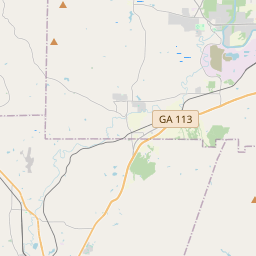Inscription
In 1866, George N. Bernard photographed Allatoona looking north from approximately the same location is this marker. The Western & Atlantic Railroad from Atlanta to Chattanooga penetrated the Allatoona Mountain range at this point through a 175 foot deep cut. Allatoona, a small community alongside the rail, was intersected by several imported wagon roads.
The plantation residents photographed on the far left is the John Clayton (now Mooney) house. This privately owned structure looks much the same today as in the Bernard photograph. Pictured immediately left of the railroad tracks stood the Allatoona train depot. Across the tracks were the warehouses and sheds in which large quantities of Federal supplies were stored at the time of the battle. Built to defend the railroad below, the Star Ford is visible atop the hill on the left. The Tennessee wagon road winds northward up and over the hill to right. The frame house once standing on top of the right hill was used as headquarters for the 4th Minnesota Infantry Regiment garrisoned at Allatoona. During construction of the defenses, Union forces removed trees on both hill to provide a clear field of fire. Over time, heavy forest growth reclaimed most of the battlefield.
(sidebar)
Images of War and Life
Advances in photography shortly before the beginning of America´s War Between the States provided the public with images of battles, heroism, and death such as they had never seen before. Photographers like George Barnard, Mathew Brady, Alexander Gardner, Timothy O´ Sullivan, and George Cook worked to document the epic battles along the along with the everyday lives of both Northerners and Southerners.
George Bernard´s famous photographs the Allatoona are the result of his role as an official photographer of the U.S. Army. Others work independently or for the various newspapers and magazines. Newspapers and magazines of that day did not yet possess the technology required for printing photographs; therefore, engravers created images from photographs and sketches. Artist, such as Alford and William Ward, Thomas Nast, and Edwin Forbes provided "Harper´s Weekly," "Harper´s New Monthly Magazine," "Frank Leslie´s Illustrated Newspaper," and "The London Illustrated News" with war images for their subscribers.
The plantation residents photographed on the far left is the John Clayton (now Mooney) house. This privately owned structure looks much the same today as in the Bernard photograph. Pictured immediately left of the railroad tracks stood the Allatoona train depot. Across the tracks were the warehouses and sheds in which large quantities of Federal supplies were stored at the time of the battle. Built to defend the railroad below, the Star Ford is visible atop the hill on the left. The Tennessee wagon road winds northward up and over the hill to right. The frame house once standing on top of the right hill was used as headquarters for the 4th Minnesota Infantry Regiment garrisoned at Allatoona. During construction of the defenses, Union forces removed trees on both hill to provide a clear field of fire. Over time, heavy forest growth reclaimed most of the battlefield.
(sidebar)
Images of War and Life
Advances in photography shortly before the beginning of America´s War Between the States provided the public with images of battles, heroism, and death such as they had never seen before. Photographers like George Barnard, Mathew Brady, Alexander Gardner, Timothy O´ Sullivan, and George Cook worked to document the epic battles along the along with the everyday lives of both Northerners and Southerners.
George Bernard´s famous photographs the Allatoona are the result of his role as an official photographer of the U.S. Army. Others work independently or for the various newspapers and magazines. Newspapers and magazines of that day did not yet possess the technology required for printing photographs; therefore, engravers created images from photographs and sketches. Artist, such as Alford and William Ward, Thomas Nast, and Edwin Forbes provided "Harper´s Weekly," "Harper´s New Monthly Magazine," "Frank Leslie´s Illustrated Newspaper," and "The London Illustrated News" with war images for their subscribers.
Details
| HM Number | HM1N0G |
|---|---|
| Tags | |
| Placed By | Georgia State Parks & Historic Sites |
| Marker Condition | No reports yet |
| Date Added | Tuesday, August 18th, 2015 at 9:02am PDT -07:00 |
Pictures
Locationbig map












| UTM (WGS84 Datum) | 16S E 710756 N 3777153 |
|---|---|
| Decimal Degrees | 34.11400000, -84.71496667 |
| Degrees and Decimal Minutes | N 34° 6.84', W 84° 42.898' |
| Degrees, Minutes and Seconds | 34° 6' 50.4" N, 84° 42' 53.88" W |
| Driving Directions | Google Maps |
| Area Code(s) | 678, 770 |
| Closest Postal Address | At or near Allatoona Pass, Cartersville GA 30121, US |
| Alternative Maps | Google Maps, MapQuest, Bing Maps, Yahoo Maps, MSR Maps, OpenCycleMap, MyTopo Maps, OpenStreetMap |
Is this marker missing? Are the coordinates wrong? Do you have additional information that you would like to share with us? If so, check in.
Nearby Markersshow on map
Show me all markers in: Cartersville, GA | Bartow County | 30121 | Georgia | United States of America
Maintenance Issues
- Is this marker part of a series?
- What historical period does the marker represent?
- What historical place does the marker represent?
- What type of marker is it?
- What class is the marker?
- What style is the marker?
- Does the marker have a number?
- What year was the marker erected?
- This marker needs at least one picture.
- Can this marker be seen from the road?
- Is the marker in the median?

Comments 0 comments